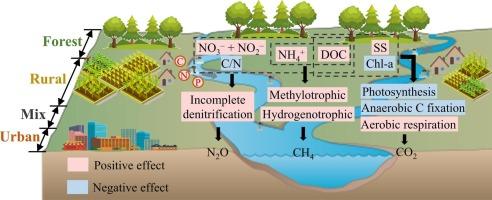Rural river reaches are emission hotspots for greenhouse gases
IF 6.3
1区 地球科学
Q1 ENGINEERING, CIVIL
引用次数: 0
Abstract
Rivers play a pivotal role in the global carbon and nitrogen biogeochemical cycles, contributing disproportionately to the global budget of greenhouse gas (GHG) relative to their areas. Rural river reaches are particularly affected by anthropogenic activities and may serve as significant GHG emission hotspots, while previous studies have focused primarily on GHG emissions from urban sewage treatment and agricultural systems, the effects of decentralized sewage treatment tailwater and agricultural return flow on riverine GHG dynamics remains poorly understood. In this study, we used metagenomic sequencing and microbial taxonomic annotation to investigate GHG production mechanism in a subtropical river receiving agricultural return flow and decentralized sewage treatment tailwater. We found that the global warming potential of rural river reaches surpassed that of other river reaches by 283.6 % and 298.9 % on 20- and 100-year time scales, respectively. These elevated GHG levels were linked to increased nutrient and organic matter loading, along with pronounced shifts in the abundance of functional genes related to GHG production and consumption in the rural river reaches. N2O production was primarily driven by incomplete denitrification facilitated by abundant denitrification substrates. Concurrently, reduced photosynthesis and aerobic CO2 fixation, coupled with strong aerobic respiration, led to high CO2 production. Despite substantial aerobic CH4 oxidation, the continuous availability of methanogenic substrates and alternative CH4 oxidation substitutes sustained CH4 production. These were controlled by methylotrophic and hydrogenotrophic methanogenesis during the wet and dry periods, respectively. These findings emphasize the need to improve the collection rate and treatment efficiency of rural domestic sewage and strengthen the control of agricultural non-point source pollution, so as to better mitigate the indirect greenhouse effect of sewage and fertilization in rural regions.

农村河流流域是温室气体的排放热点
河流在全球碳和氮生物地球化学循环中发挥着关键作用,对全球温室气体(GHG)预算的贡献与其面积不成比例。农村河段受人为活动的影响特别大,可能成为重要的温室气体排放热点,而以往的研究主要集中在城市污水处理和农业系统的温室气体排放上,分散的污水处理尾水和农业回流对河流温室气体动态的影响尚不清楚。本研究采用宏基因组测序和微生物分类注释的方法,对亚热带河流农业回流和分散污水处理尾水的温室气体产生机制进行了研究。在20年和100年的时间尺度上,农村河段的全球变暖潜势分别比其他河段高283.6%和298.9%。这些升高的温室气体水平与营养物质和有机物负荷的增加有关,同时与农村河流流域温室气体生产和消费相关的功能基因丰度的显著变化有关。N2O的产生主要是由丰富的反硝化底物促进的不完全反硝化驱动的。同时,光合作用和有氧CO2固定减少,加上强有氧呼吸,导致二氧化碳产量高。尽管有大量的有氧CH4氧化,产甲烷底物和替代CH4氧化替代物的持续可用性维持了CH4的产生。湿期和干期分别受甲基营养产甲烷和氢营养产甲烷控制。这些结果强调了提高农村生活污水的收集率和处理效率,加强农业面源污染的控制,以更好地缓解农村地区污水和施肥的间接温室效应。
本文章由计算机程序翻译,如有差异,请以英文原文为准。
求助全文
约1分钟内获得全文
求助全文
来源期刊

Journal of Hydrology
地学-地球科学综合
CiteScore
11.00
自引率
12.50%
发文量
1309
审稿时长
7.5 months
期刊介绍:
The Journal of Hydrology publishes original research papers and comprehensive reviews in all the subfields of the hydrological sciences including water based management and policy issues that impact on economics and society. These comprise, but are not limited to the physical, chemical, biogeochemical, stochastic and systems aspects of surface and groundwater hydrology, hydrometeorology and hydrogeology. Relevant topics incorporating the insights and methodologies of disciplines such as climatology, water resource systems, hydraulics, agrohydrology, geomorphology, soil science, instrumentation and remote sensing, civil and environmental engineering are included. Social science perspectives on hydrological problems such as resource and ecological economics, environmental sociology, psychology and behavioural science, management and policy analysis are also invited. Multi-and interdisciplinary analyses of hydrological problems are within scope. The science published in the Journal of Hydrology is relevant to catchment scales rather than exclusively to a local scale or site.
 求助内容:
求助内容: 应助结果提醒方式:
应助结果提醒方式:


